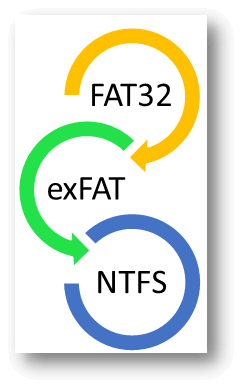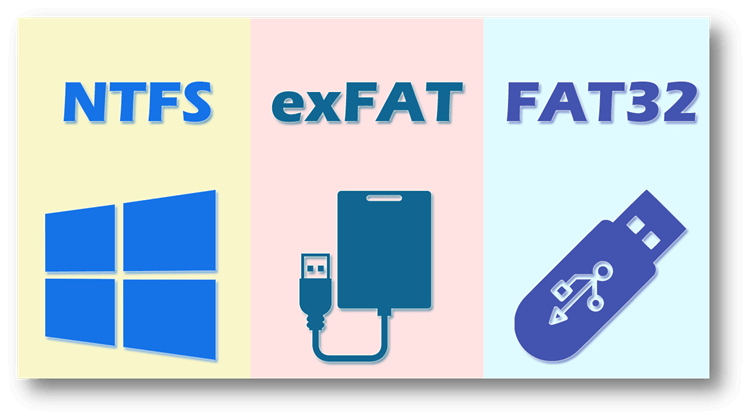Quick Navigation:
- 1. What is a file system?
- 2. What is FAT32?
- 3. What is exFAT?
- 4. FWhat is NTFS?
- 5. FAQs About ExFAT vs FAT32 vs NTFS
Although file systems are rarely the center of attention, they must be practical. NTFS, FAT32, and exFAT are all explained here.
USB flash drives can be formatted using the FAT32, exFAT, or NTFS file systems when working in a Windows environment. In contrast to the original FAT file system, which was only used by the MS-DOS operating system, FAT32 is a fully developed file system.
The NTFS file system, developed by Microsoft, was introduced later and greatly improved the efficiency and dependability of working with files. In 2006, Microsoft released the exFAT file system, designed for use with flash drives and other devices when space is at a premium. Learn the key distinctions between the exFAT and NTFS file systems.
What is a file system?
The file system is a set of data structures and algorithms that translate logical file operations into their respective storage locations on the physical storage medium. A computer's file system controls the organization and accessibility of stored information.
Information stored on a device without a file system would appear as a continuous data stream, with no means to distinguish between individual files.

What is FAT32?
The FAT32 file system is widely deployed on both fixed and removable media. Files are kept in FAT32 as a table containing a linked list of blocks. The terms "blocks" and "sectors" are likely familiar to you from your experience with the chkdsk command during a repair of a FAT file system.
The File Allocation Table on a FAT32 drive contains an index for each block that makes up a file. One column indicates whether the block contains data or is available for new entries; another provides a pointer to the next file block. The "next" column also displays the file's completion status.
Advantages of FAT32:
- Partition sizes in FAT32 can go up to 2 terabytes.
- FAT16 can only handle 2GB partitions.
- Since FAT32's minimum cluster size is still just 4KB for partitions under 8GB, it is far more efficient at managing huge partitions.

What is exFAT?
Microsoft also presented exFAT or the Extended File Allocation Table. It was introduced in 2006 to succeed FAT32. It works with previous Windows releases. exFAT also performs well on flash memory. This enhancement was made to help the speed of flash memory devices like SD cards and USB drives.
The SD Association officially approved it as the standard file format for SDXC cards with more than 32 GB capacity. exFAT is compatible with multiple OSes, including Mac OS X and Linux. For the quickest read/write speeds, external hard drive formats like exFAT are now the norm for devices like external SSDs.
Advantages of exFAT:
- Recovering accidentally deleted files from the exFAT storage system is possible.
- Recover Windows exFAT files after formatting.
- A memory card, memory stick, hard drive, USB drive, etc., can have their data salvaged with its aid.
- It's useful if you need to store files significantly bigger than FAT32's 4 GB limit.
- There are no sensible constraints on file size or partition size.
What is NTFS:
Almost all contemporary internal hard drives and solid state drives use this latest file system designed by Microsoft.
The acronym "NTFS" means "New Technology File System. Your home computer probably uses NTFS because Windows can only be installed on an NTFS drive.
With journaling, no practical limits on file size, support for compression and long file names, file access control for server administrators, and much more, it's no surprise that this file system is the default for OS devices. If you and your family solely use Windows, there's no reason not to format all of your disks (both fixed and removable) with NTFS.
However, Mac OSes can only read NTFS files; they cannot write to them without additional software. If you insert an NTFS-formatted flash drive into a Mac, you can read its contents and make copies, but you won't be able to make any changes or add any new files.
Advantages of NTFS:
- Files are encrypted using the Encryption File System (EFS), making this method extremely safe.
- Even in partitions larger than 400 MB, it operates admirably.
- It's more resistant to breaking apart into little pieces.

FAQs About ExFAT vs FAT32 vs NTFS:
Normally, if you want to a file system for a device which will be used on both Windows and Mac, just choose ExFAT or FAT32, if you want to use an external hard drive on Windows, just select NTFS.
- Open Disk Utility.
- Click the NTFS drive.
- Click on Erase button. Give the drive a name, then select a file system: ExFAT or FAT32.
- Click on Erase button again.
- Once the process gets finished, click on Done button.
Both of them are widely used on USB flash drives and memory cards or external drives. FAT32 only supports files up to 4GB but it can work on very old Windows or device versions. ExFAT does has the file size limitation, but it does not support old Windows versions.
NO, Mac does not support NTFS drive read-write. If you want to use a NTFS hard drive on Mac, you’d better format it to APFS, ExFAT or FAT32.
Just connect the hard drive on Windows PC, then open Disk Management, select the hard drive. Right-click the hard drive, choose Format, select a file system and format it.
Conclusion:
File systems are just one type of technology with scenario-specific requirements. We know why Windows 10 won't let you use FAT32 for the primary operating system partition. NTFS is required for Windows 10 and later. We also understand why your twenty-gigabyte raw video clip will not transfer to a FAT32 USB drive. sFAT32 does not support file sizes greater than 4GB.
With our newfound knowledge of FAT32, NTFS, and ExFAT, we can better understand the rationale behind our varied file-system preferences. Which data storage format do you find most convenient?
